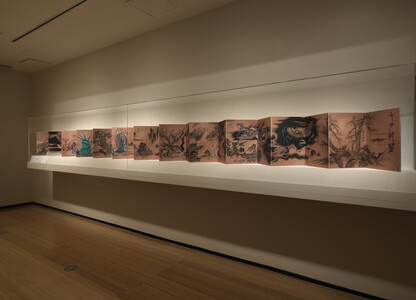Group Exhibition Asia Society Museum, New York, U.S.A.
The inaugural Asia Society Triennial, a festival of art, ideas, and innovation, is slated to run October 27, 2020 through June 27, 2021. This first edition of the Asia Society Triennial, titled We Do Not Dream Alone, will be composed of a multi-venue exhibition, interdisciplinary panels, forums, and performances.
Part 1: October 27, 2020–February 7, 2021
Part 2: March 26, 2021–June 27, 2021
As we enter the third decade of the twenty-first century, the battle lines have been drawn over what kind of society we should have. The current challenge to the post-WW2 liberal-democratic status quo has its roots in the excesses of globalization with its denudation of local identities and enlargement of economic inequalities under global capitalism. Within the modern nation-state, tribalism and rising authoritarianism have frayed historical ties between states and cultures: North vs. South, East vs. West, Middle East vs. West, and on and on. This fracturing is mirrored within the modern state itself, with citizens increasingly clustering around religious, gender, sexual, ethnic, and, of course, class identities. Edward Said has commented about how within nations, those forces aligning themselves with the “orthodox,” “conservative,” and “mainstream” view culture as forming separately from other cultures and that there is a definable “pure” culture, our culture. Conservative movements often look back to a historical golden age that may not have existed. There is thus an increasing inability to recognize the mutually constitutive nature of all cultures. Every culture contains a palimpsest of past cross-cultural encounters and also continues to be shaped by absorption, transmission, and negotiation with others. Being global is therefore also a condition of how we exist and not merely a stage in our development. The existence of diasporic and immigrant communities or ethnic minorities throughout history is a direct consequence of this. It is no wonder that as the COVID-19 pandemic continues, the ugliest battles are now unfolding around systematic racism and xenophobic attacks on African American, Asian, and LGBTQIA+, and other minority communities.
Bruno Latour, in an interview with the French online magazine AOC published on March 29, 2020, as the COVID-19 pandemic exploded worldwide, notes that the devastating effects of the virus on the economy and society has ironically proven how pervasive and deeply embedded each of us is in the global networks of ideas, people, goods, and money. The virus as a global interrupter has, in fact, become the ultimate proof of how globalized we all are.
What is the role of art and artists in this fraught situation?
Taking inspiration from a line in Yoko Ono’s 1964 publication Grapefruit, “A dream you dream alone may be a dream, but a dream two people dream together is a reality,” the title of the Triennial, “We Do Not Dream Alone,” attests to the power of art to resist our urge to silo during these uncertain times. Grapefruit, now considered a masterpiece of conceptual art, contains a series of “event scores” that provide instructions for simple, even daily actions the reader might enact as a way of life. These suggest the possibility of the efficacy of micro-actions and human agency, of particular resonance now when governments and public institutions seem to fail us.
This inaugural Triennial, which encompasses visual art, theater, dance, music, and film, takes place in a nation-state on the eve of its citizens going to the ballot boxes to choose which dream of America will take hold. Leaping across geography and history, the artistic projects in this Triennial resist the condition of dreaming alone by unveiling the way people, objects, and events across time and space are linked through a complex web of relationships. The objects and processes of contemporary art are micro-acts of world-building creating micro-worlds of meaning and relations that reveal the border-crossing nature of our modern existence despite the current lines in the sand. For instance, Ken + Julia Yonetani’s Three Wishes connects the radiation tragedy of Fukushima with its long-term impacts on wildlife and, by implication, human life, to the effusiveness and cheeriness of victorious America’s postwar embrace of a nuclear-powered future. A special project within the exhibition, We The People: Xu Bing and Sun Xun Respond to the Declaration of Independence, pairs an official nineteenth-century print of the Declaration of Independence with new work by the Chinese artists Xu Bing and Sun Xun as a launchpad to ruminate on the early American leaders’ fascination with classical Chinese civilization, particularly the political philosophy of Confucius, as they were dreaming of a new nation that would seemingly be free of feudal bondages and elitist traditions. Mina Cheon’s Eating ChocoPie stages a moment of sweet communion when the public are invited to take away and consume the ubiquitous Korean dessert, the Choco-Pie. This participatory installation seizes upon the role of this dessert that, by way of a complicated political history between the divided Koreas, has become highly desired on both sides of the political border. Separated politically, but united by their love for this simple sweet, Cheon’s project amplifies the ironic separation and connection between the two states. At a crucial point in her participatory concert in the Patricia D. Klingenstein Library of the New-York Historical Society, percussionist and composer Susie Ibarra invites the audience to co-create the musical score “on the fly,” connecting performer and audience in a transitory moment of dreaming up a shared experience.
Underlying the Triennial is our belief in the power of art, its innate ability to embrace the paradoxes and contradictions of our increasingly complex global society while retaining the capacity to illuminate the thread of our shared humanity.
The presence of art shows that we are never alone in life and our dreams. We invite you to dream with us.
Boon Hui Tan
Artistic Director
More Pictures:






